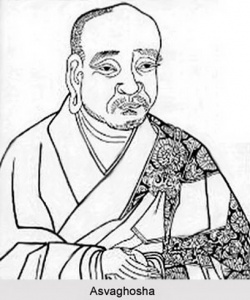Difference between revisions of "Aśvaghoṣa"
(Created page with "thumb|250px| Aśvaghoṣa, whose name means ‘horse’s voice,’ was one of India’s greatest poets. He was born in Sāketa in the 2nd century ...") |
|||
| Line 1: | Line 1: | ||
[[File:Asvaghosha-14op.jpg|thumb|250px|]] | [[File:Asvaghosha-14op.jpg|thumb|250px|]] | ||
| − | Aśvaghoṣa, whose name means ‘horse’s voice,’ was one of India’s greatest poets. He was born in Sāketa in the 2nd century CE, he converted to Buddhism in his youth, and became court poet to King Kaniṣka. The | + | '''Aśvaghoṣa''', whose name means ‘horse’s voice,’ was one of India’s greatest poets. He was born in Sāketa in the 2nd century CE, he converted to [[Buddhism]] in his youth, and became court poet to King [[Wikipedia:Kanishka|Kaniṣka]]. The [[Buddha]]’s teachings had by then brought about a revolution in Indian [[religious]] and [[philosophical]] thought, as well as in the arts too. Within 500 years of the [[Buddha]]’s passing, [[Buddhists]] were using all the visual and literary arts to draw people towards the [[Dhamma]], explain it to them and awaken their faith. [[Aśvaghoṣa]] epitomised this movement. He wrote the Saundarānandakāvya, a poem retelling the conversion of the [[Buddha]]’s cousin [[Wikipedia:Nanda|Nanda]]; the Sāriputraprakaraṇa, a play in nine acts about the life of [[Sāriputta]]; the Gaṇḍistotra, a charming [[Wikipedia:eulogy |eulogy]] to the [[monastery]] bell and the Vajrasuci, a detailed critique of the Hindu [[Wikipedia:caste |caste]] system. But [[Aśvaghoṣa]]’s most famous work was the [[Wikipedia:Buddhacarita|Buddhacarita]], a retelling of the life of the [[Buddha]], which had a profound effect on the cultured class and later influenced a many great [[Sanskrit]] poets. |
Asvaghosa and His Times,Sarla Khosla, 1986. | Asvaghosa and His Times,Sarla Khosla, 1986. | ||
Revision as of 00:28, 2 July 2013
Aśvaghoṣa, whose name means ‘horse’s voice,’ was one of India’s greatest poets. He was born in Sāketa in the 2nd century CE, he converted to Buddhism in his youth, and became court poet to King Kaniṣka. The Buddha’s teachings had by then brought about a revolution in Indian religious and philosophical thought, as well as in the arts too. Within 500 years of the Buddha’s passing, Buddhists were using all the visual and literary arts to draw people towards the Dhamma, explain it to them and awaken their faith. Aśvaghoṣa epitomised this movement. He wrote the Saundarānandakāvya, a poem retelling the conversion of the Buddha’s cousin Nanda; the Sāriputraprakaraṇa, a play in nine acts about the life of Sāriputta; the Gaṇḍistotra, a charming eulogy to the monastery bell and the Vajrasuci, a detailed critique of the Hindu caste system. But Aśvaghoṣa’s most famous work was the Buddhacarita, a retelling of the life of the Buddha, which had a profound effect on the cultured class and later influenced a many great Sanskrit poets.
Asvaghosa and His Times,Sarla Khosla, 1986.
